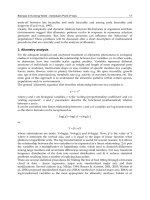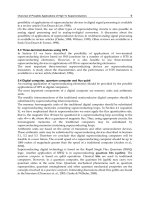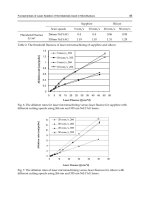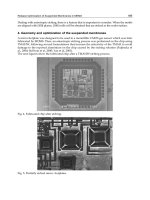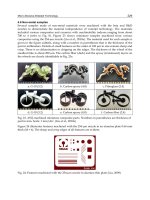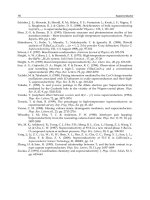Active Visual Inference of Surface Shape - Roberto Cipolla Part 2 pot
Bạn đang xem bản rút gọn của tài liệu. Xem và tải ngay bản đầy đủ của tài liệu tại đây (1.13 MB, 15 trang )
6 Chap. 1. Introduction
.
line and arc primitives are
apparent contours
(see below). These do
not convey a curved surface's shape in the same way. Their con-
tour generators move and deform over a curved object's surface as
the viewpoint is changed. These can defeat many stereo and struc-
ture from motion algorithms since the features (contours) in different
viewpoints are projections of different scene points. This is effectively
introducing non-rigidity.
9 Representation
Many existing methods make explicit quantitative depths of visible
points [90, 7, 96]. Surfaces are then reconstructed from these sparse
data by interpolation or fitting surface models - the plane being a par-
ticularly common and useful example. For arbitrarily curved, smooth
surfaces, however, no surface model is available that is general enough.
The absence of adequatc surface models and the sparsity of surface fea-
tures make dcscribing and inferring geometric information about 3D curved
objects from visual cues a challenging problem in computer vision. Devel-
oping theories and methods to recover reliable descriptions of arbitrarily
curw~A smooth smTaces is one of the major themes of this thesis.
Robustness
The lack of robustness of computer vision systems compared to biological
systems has led many to question the suitability of existing computational
theories [194]. Many existing methods are inadequate or incomplete and
require development to make then robust and capable of recovering from
errol?.
Existing structure from motion algorithms have proved to be of little or
no practical use when analysing images in which perspective effects are
small. Their solutions are often ill-conditioned, and fail in the presence of
small quantities of image measurement noise; when the field of view and
the variation of depths in the scene is small; or in the prescnce of small
degrees of non-rigidity (see Chapter 5 for details). Worst, they often fail
in particularly graceless fashions [197, 60]. Yet the human visual system
gains vivid 31) impressions from two views (even orthographic ones) even
in the presence of non-rigidity []31].
Part of the problem lies in the way these problems have been formulated.
Their formulation is such that the interpretation of point image velocities
or disparities is embroilcd in camera calibration and making explicit quan-
titative depths. Reformulating these problems to make them less sensitive
to measurement error and epipolar geometry is another major theme of
this thesis.
1.2. Approach 7
1.2 Approach
This thesis develops computational theories relating visual motion to the differ-
ential geometry of visible surfaces. It shows how an
active
monocular observer
can make deliberate movements to recover reliable descriptions of visible surface
geometry. The observer then acts on this information in a number of visually
guided tasks ranging from navigation to object manipulation.
The details of our general approach are listed below. Some of these ideas
have recently gained widespread popularity in the vision research community.
1.2.1 Visual motion and differential geometry
Attention is restricted to arbitrarily curved, piecewise smooth (at the scale of
interest) surfaces. Statistically defined shapes such as textures and crumpled
fractal-like surfaces are avoided. Piecewise planar surfaces are considered as a
special ease. The mathematics of differential surface geometry [67, 122] and 3D
shape play a key role in the derivation and exposition of the theories presented.
The deformation of visual curves arising from viewer motion is related to surface
geometry.
1.2.2 Active vision
The inherent practical difficulties of structure from motion algorithms are avoided
by allowing the viewer to make deliberate, controlled movements. This has been
termed active vision [9, 2]. As a consequence, it is assumed that the viewer has at
least some knowledge of his motions, although this may sometimes be expressed
qualitatively
in
terms of uncertainty bounds [106, 186]. Partial knowledge of
viewer motion, in particular constraints on the viewer's translation, make the
analysis of visual motion considerably easier and can lead to simple, reliable
solutions to the structure from motion problem. By controlling the viewpoint,
we can achieve non-trivial visual tasks without having to solve completely this
problem.
A moving active observer can also more robustly make inferences about the
geometry of visible surfaces by integrating the information from different view-
points, e.g. using camera motion to reduce error by making repeated measure-
ments of the same features [7, 96, 173]. More important, however, is that con-
trolled viewpoint movement can be used to reduce ambiguity in interpretation
and sparsity of data by uncovering desired geometric structure. In particular it
may be possible to generate new data by moving the camera so that a contour is
generated on a surface patch for which geometrical data is required, thus allow-
ing the viewer to fill in the gaps of unknown areas of the surface. The judicious
choice and change of viewpoint can generate valuable data.
8 Chap. 1. Introduction
1.2.3 Shape representation
Listed below are favourable properties desired in a shape descriptor.
1. It should be insensitive to changes in viewpoint and illumination, e.g. im
variant measures such as the principal curvatures of a surface patch.
2. It should be robust to noise and resistant to surface perturbations, obeying
the principle of graceful degradation:
wherever possible, degrading the data will not prevent
delivery of at least some of the answer [144].
3. It should be computationally efficient, the latter being specified by the
application.
Descriptions of surface shape cover a large spectrum varying from quanti-
tative depth maps (which are committed to a single surface whose depths are
specified over a dense grid [90]) to a general qualitative description (which are
incomplete specifications such as classifying tile surface locally as either elliptic,
hyperbolic or planar [20]). Different visual tasks will demand different shape de-
scriptors within this broad spectrum. The specification is of course determined
by the application. A universal 3D or 21D sketch [144] is as elusive as a universal
structure from motion algorithm.
In our approach we abandon the idea of aiming to produce an explicit surface
representation such as a depth map from sparse data [144, 90, 192, 31]. The main
drawbacks of this approach are that it is computationally difficult and the fine
grain of the representation is cumbersome. The formulation is also naive in the
following respects. First, there is no unique surface which is consistent with the
sparse data delivered by early visual modules. There is no advantage in defining a
best consistent surface since it is not clear why a visual system would require such
an explicit representation. Direct properties of the surfaces such as orientation
or curvature are preferred. Second, the main purpose of surface reconstruction
should be to make explicit occlusion boundaries and localise discontinuities in
depth and orientation. These are usually more important shape properties than
credence on the quality of smoothness.
Qualitative or partial shape descriptors include the incomplete specification
of properties of a surface in terms of bounds or constraints; spatial order [213],
relative depths, orientations and curvatures; and affine 3D shape (Euclidean
shape without a metric to specify angles and distances [131]). These descriptions
may superficially seem inferior. They are, however, vital, especially when they
1.3. '['hemes and contributions 9
can be obtained cheaply and reliably whereas a complete specification of the
surface may be cumbersome. It will be shown that they can be used successfully
in a variety of visual tasks.
Questions of representation of shape and uncertainty should not be treated
in isolation. The specification depends on what the representation is for, and
what tasks will be performed with it. Shape descriptions must be useful.
1.2.4 Task oriented vision
A key part of the approach throughout this thesis is to test the utility, efficiency
and reliability of the proposed theories, methods and shape representations in
"real" visual tasks, starting from visual inputs and transforming them into rep-
resentations upon which reasoning and planning programs act. 1 In this way
"action"
is linked to
"perception".
In this thesis visual inferences are tested in
a number of visual tasks, including navigation and object manipulation.
1.3 Themes and contributions
The two main themes of this thesis are interpreting the images of curved surfaces
and robustness.
1.3.1 Curved surfaces
Visual cues to curved surface shape include outlines (apparent contour [120]),
silhouettes, specularities (highlights [128]), shading and self-shadows [122], cast
shadows, texture gradients [216] and the projection of curves lying on sur-
faces [188]. These have often been analysed in single images from single view-
points. In combination with visual motion resulting from deliberate viewer mo-
tions (or similarly considering the deformations between the images in binocular
vision) some of these cues become very powerful sources of geometric informa-
tion. Surfaces will be studied by way of the image (projection) of curves on
surfaces and their deformation under viewer motion. There are two dominant
sources of curves in images. The first source occurs at the singularity of the
mapping between a patch on the surface and its projection [215]. The patch
projects to a smooth piece of contour which we call the
apparent contour
or out-
line. This occurs when viewing a surface along its tangent plane. The apparent
contour is the projection of a fictitious space curve on the surface - the
contour
generator-
which separates the surface into visible and occluded parts. Shape
recovery from these curves will be treated in Chapter 2 and 3. Image curves also
can arise when the mapping from surface to image is not singular. The visual
tThis approach is also known as purposive, animate, behavioural or utilitarian vision.
10 Chap. 1. Introduction
image of curves or patches on the surface due to internal surface markings or
illumination effects is simply a deformed map of the surface patch. This type of
image curve or patch will be treated in Chapters 4 and 5.
1.3.2 Robustness
This thesis also makes a contribution to achieving reliable descriptions and ro-
bustness to measurement and ego-motion errors. This is achieved in two ways.
The first concerns sensitivity to image measurement errors. A small reduction in
sensitivity can be obtained by only considering features in the image that can be
reliably detected and extracted. Image curves (edges) and their temporal evolu-
tion have such a property. Their main advantage over isolated surface markings
is technological. Reliable and accurate edge detectors are now available which
localise surface markings to sub-pixel accuracy [48]. The technology for isolated
point/corner detection is not at such an advanced stage [164]. Furthermore,
snakes [118] are ideally suited to tracking curves through a sequence of images,
and thus measuring the curve deformation. Curves have another advantage.
Unlike points ("corners") which only samples the surface at isolated points - the
surface could have any shape in between the points - a surface curve conveys
information, at a particular scale, throughout its path.
The second aspect of robustness is achieved by overcoming sensitivity to the
exact details of viewer motion and epipolar geometry. It will be seen later that
point image velocities consist of two components. The first is due to viewer
translation and it is this component that encodes scene structure. The other
component is due to the rotational part of the observer's motion. These rota-
tions contribute no information about the structure of the scene. This is obvious,
since rotations about the optical centres leave the rays, and hence the triangu-
lation, unchanged. The interpretation of point image velocities or disparities as
quantitative depths, however, is complicated by these rotational terms. In par-
ticular small errors in rotation (assumed known from calibration or estimated
from structure from motion) have large effects on the recovered depths.
Instead of looking at point image velocities and disparities (which are em-
broiled in epipolar geometry and making quantitative depths explicit), part of
the solution, it is claimed here, is to look at local, relative image motion. In
particular this thesis shows that relative image velocities and velocity/disparity
gradients are valuable cues to surface shape, having the advantage that they are
insensitive to the exact details of the viewer's motion. These cues include:
1. Motion parallax - the relative image motion (both velocities and accel-
erations) of nearby points (which will be considered in Chapters 2 and
3).
1.4. Outline of book 11
2. The deformation of curves (effectively the relative motion of three nearby
points) (considered in Chapter 4).
3. The local distortion of apparent image shapes (represented as an affine
transformation) (considered in Chapter 5).
Undesirable global additive errors resulting from uncertainty in viewer motion
and the contribution of viewer rotational motion can be cancelled out. We
will also see that it is extremely useful to base our inferences of surface shape
directly on properties which can be measured in the image. Going through the
computationally expensive process of making explicit image velocity fields or
attempting to invert the imaging process to produce 3D depths will often lead
to ill-conditioned solutions even with regularisation [t69].
1.4 Outline of book
Chapter 2 develops new theories relating the visual motion of apparent contours
to
the geometry of the visible surface. First, existing theories are generalised [85]
to show that spatio-temporal image derivatives (up to second order) completely
specify the visible surface in the vicinity of the apparent contour. This is shown
to be sensitive to the exact details of viewer motion. '/he relative motion of
image curves is shown to provide robust estimates of surface curvature.
Chapter 3 presents the implementation of these theories and describes re-
sults with a camera mounted on a moving robot arm. A eomputationally efficient
method of extracting and tracking image contours based on B-spline snakes is
presented. Error and sensitivity analysis substantiate the clairns that parallax
methods are orders of magnitude less sensitive to the details of the viewer's
motion than absolute image measurements. The techniques are used to detect
apparent contours and discriminate them from other fixed image features. They
are also used to recover the 3D shape of surfaces in the vicinity of their apparent
contours. We describe the real-time implementations of these algorithms for use
in tasks involving the active exploration of visible surface geometry. The visually
derived shape information is successfully used in modelling, navigation and the
manipulation of piecewise smooth curved objects.
Chapter 4 describes the constraints placed on surface differential geometry
by observing a surface curve from a sequence of positions. The emphasis is on
aspects of surface shape which can be recovered efficiently and robustly and with-
out tile requirement of the exact knowledge of viewer motion or accurate image
measurements. Visibility of the curve is shown to constrain surface orientation.
Further, tracking image curve inflections determines the sign of the normal cur-
vature (in the direction of tile surface curve's tangent vector). Examples using
12 Chap. 1. Introduction
this
information
in real image sequences are included.
Chapter 5 presents a novel method to measure the
differential invariants
of the image velocity field robustly by computing average values from the in-
tegral of norrnal image velocities around closed contours. This avoids having
to recover a dense image velocity field and taking partial derivatives. Moreover
integration provides some immunity to image measurement noise. It is shown
how an
active
observer making small, deliberate (although imprecise) motions
can recover precise estimates of the divergence and deformation of the image
velocity field and can use these estimates to determine the object surface orien-
tation and time to contact. The results of real-time experiments in which this
visually derived information is used to guide a robot manipulator in obstacle
collision avoidance, object manipulation and navigation are presented. This is
achieved without camera calibration or a complete specification of the epipolar
geometry.
A survey of the literature (including background information for this chap-
ter) highlighting thc shortcomings of many existing approaches, is included in
Appendix A under bibliographical notes. Each chapter will review relevant ref-
erences.
Chapter 2
Surface Shape from the Deformation of
Apparent Contours
2.1 Introduction
For a smooth arbitrarily curved surface - especially in man-made environments
where surface texture may be sparse - the dominant image feature is the
apparent
contour
or silhouette (figure 2.1). The apparent contour is the projection of the
locus of points on the object - the
contour generator
or
cxtremal boundary -
which separates the visible from the occluded parts of a smooth opaque, curved
surface.
The apparent contour and its deformation under viewer motion are poten-
tially rich sources of geometric information for navigation, object manipulation,
motion-planning and object recognition. Barrow and Tenenbaum [17] pointed
out that surface orientation along the apparent contour can be computed di-
rectly from image data. Koenderink [120] related the curvature of an apparent
contour to the intrinsic curvature of the surface (Gaussian curvature); the sign
of Gaussian curvature is equal to the sign of the curvature of the image contour.
Convexities, concavities and inflections of an apparent contour indicate, respec-
tively, convex, hyperbolic and parabolic surface points. Giblin and Weiss [85]
have extended this by adding viewer motions to obtain quantitative estimates
of surface curvature. A surface (excluding concavities in opaque objects) can
be reconstructed from the envelope of all its tangent planes, which in turn are
computed directly from the family of apparent contours/silhouettes of the sur-
face, obtained under motion of the viewer. By assuming that the viewer follows
a great circle
of viewer directions around the object they restricted the problem
of analysing the envelope of tangent planes to the less general one of comput-
ing the envelope of a family of lines in a plane. Their algorithm was tested on
noise-free, synthetic data (on the assumption that extremal boundaries had been
distinguished from other image contours) demonstrating the reconstruction of a
planar curve under orthographic projection.
In this chapter this will be extended to the general case of arbitrary non-
planar,
curvilinear viewer motion under perspective projection. The geometry
14 Chap. 2. Surface Shape from the Deformation of Apparent Contours
Figure 2.1: A smooth curved surface and its silhouette.
A single image of a smooth curved surface can provide 31) shape information f~vm
shading, surface markings and texture cues (a). However, especially in artificial
environments where surface texture may be sparse, the dominant image feature
is the outline or apparent contour, shown here as a silhouette (b). The apparent
contour or silhouette is an extremely rich source of geometric information. The
special relationship between the ray and the local differential surface 9eometry
allow the recovery of the surface orientation and the sign of Gaussian curvature
from a single view.
2.2. Theoretical framework 15
of apparent contours and their deformation under viewer-motion are related to
the differential geometry of the observed objeet's surface. In particular it is
shown how to recover the position, orientation and 3D shape of visible surfaces
in the vicinity of their contour generators from the deformation of apparent
contours and
known
viewer motion. The theory for small, local viewer motions
is developed to detect extremal boundaries and distinguish them from
occlud-
ing edges
(discontinuities in depth or orientation), surface markings or shadow
boundaries.
A consequence of the theory concerns the robustness of relative measure-
ments of surface curvature based on the relative image motion of nearby points
in the image -
parallax
based measurements. Intuitively it is relatively difficult
to judge, moving around a smooth, featureless object, whether its silhouette is
extremal or not that is, whether curvature along the contour is bounded or
not. This judgement is much easier to make for objects which have at least a
few surface features. Under small viewer motions, features are "sucked" over the
extremal boundary, at a rate which depends on surface curvature. Our theoret-
ical findings exactly reflect the intuition that the "sucking" effect is a reliable
indicator of relative curvature, regardless of the exact details of the viewer's mo-
tion. Relative measurements of curvature across two adjacent points are shown
to be entirely immune to uncertainties in the viewer's rotational velocity.
2.2 Theoretical framework
In this section the theoretical framework for the subsequent analysis of apparent
contours and their deformation under viewer motion is presented. We begin
with the properties of apparent contours and their contour generators and then
relate these first to the descriptions of local 3D shape developed from the differ-
ential geometry of surfaces and then to the analysis of visual motion of apparent
contours.
2.2.1 The apparent contour and its contour generator
Consider a smooth object. For each vantage point all the rays through the van-
tage point that are tangent to the surface can be constructed. They touch the
object along a smooth curve on its surface which we call the
contour genera-
tor
[143] or alternatively the
extremal boundary
[16], the
rim
[120], the
fold
[21]
or the
critical set
of the visual mapping [46, 85] (figure 2.2).
For generic situations (situations which do not change qualitatively under
arbitrarily small excursions of the vantage point) the contour generator is part
of a smooth space curve (not a planar curve) whose direction is not in general
perpendicular to the ray direction. The contour generator is dependent on the
16 Chap. 2. Surface Shape from the Deformation of Apparent Contours
spherical perspective image
v(t 0)
apparent contour
q (s,to)
r(so,t)
contour generator
r(S,to)
Figure
2.2:
Surface and viewing geometry.
P lies on a smooth surface which is parameterised locally by
r(s,
t). For a given
vantage point,
v(t0),
the family of rays emanating from the viewer's optical
centre (C) that touch the surface defines an s-parameter curve
r(s, to) -
the
contour generator from vantage point to. The spherical perspective projection of
this contour generator - the apparent contour,
q(s, to) -
determines the direction
of rays which graze the surface. The distance along each ray, CP, is A.
2.2. Theoretical framework 17
local surface geometry and on the vantage point in a simple way which will be
elucidated below. Moreover each vantage point will, in general, generate a dif-
ferent contour generator. Movement of the viewer causes the contour generator
to "slip" over the visible surface.
The image of the contour generator - here called the apparent contour but
elsewhere also known as the occluding contour, profile, outline, silhouette or
limb - will usually be smooth (figure 2.2). It may however not be continuous
everywhere. As a consequence of the contour generator being a space curve,
there may exist a finite number of rays that are tangent not only to the surface
but also to the contour generator. At these points the apparent contour of a
transparent object will cusp. For opaque surfaces, however, only one branch of
the cusp is visible and the contour ends abruptly (see later, figure 2.5) [129, 120].
2.2.2 Surface geometry
In the following, descriptions of local 3D shape are developed directly from the
differential geometry of surfaces [67, 76, 122].
Consider a point P on the contour generator of a smooth, curved surface in R 3
and parameterised locally by a vector valued function r(s,t). The parametric
representation can be considered as covering the surface with two families of
curves [134]: r(s, t0) and r(s0,t) where so or to are fixed for a given curve in
the family. For the analysis of apparent contours and their deformation with
viewer motion it is necessary to choose the one-parameter family of views to be
indexed by a time parameter t, which will also parameterise viewer position for
a moving observer. The s and t parameters are defined so that the s-parameter
curve, r(s,t0), is a contour generator from a particular view to (figure 2.2). A
t-parameter curve r(s0, t) can be thought of as the 3D locus of points grazed by
a light-ray from the viewer, under viewer motion. Such a locus is not uniquely
defined. Given a starting point s = so, t = to, the correspondence, as the viewer
moves, between "successive" (in an infinitesimal sense) contour generators is
not unique. Hence there is considerable freedom to choose a spatio-temporal
parameterisation of the surface, r(s, t).
The local surface geometry at P is determined by the tangent plane (surface
normal) and a description of how the tangent plane turns as we move in arbitrary
directions over the surface (figure 2.3). This can be specified in terms of the basis
{r~, rt} for the tangent plane (where for convenience r8 and rt denote
Or/Os
and
Or/cgt -
the tangents to the s and t-parameter curves respectively) 1; the surface
1Subscripts denote differentiation with respect to the subscript parameter. Superscripts
will be used as labels.
18 Chap. 2. Surface Shape from the Deformation of Apparent Contours
.o~ r
r 2:to /
s-parameter cuive (th~ contour generator)
Figure 2.3: The tangent plane.
Local surface geometry can be specified in terms of the basis {rs, rt} for the
tangent plane (where rs and rt denote the tangents to the s and t-parameter
curves respectively and are not in general orthogonal) and the surface normal n
(a unit vector). In differential surface geometry the derivative of these quantities
with respect to movement over the surface is used to describe surface shape.
2.2. Theoretical framework 19
normal, (a unit vector, n) defined so that
r~.n = 0 (2.1)
rt.n 0 (2.2)
and the derivatives of these quantities with respect to movement over the surface.
These are conveniently packaged in the first and second fundamental forms as
follows. For a tangent plane vector at P, w, the first fundamental form, I(w, w),
is used to express the length of any infinitesimal element in the tangent plane
([67], p.92 ):
~(w, w) = w.w. (2.3)
It can be represented by a matrix of coefficients, G, with respect to the basis
{r,, rt} where
G= [ r~.r~ r~.rt ] . (2.4)
rt ,rs
rt .rt
The second fundamental form, II(w,w), quantifies the "bending away" of
the surface from the tangent plane. It is defined by ([67], p.141):
ii(w, w) = -w.L(w) (2.5)
where L(w) is the derivative of the surface orientation, n, in the direction w.
L is in fact a linear transformation on the tangent plane. It is also called the
Shape operator [166] or the Weingarten Map [156]. In particular for the basis
vectors {re, rt}:
L(r,) = ns (2.6)
L(rt) = nt (2.7)
and the coefficients of the second fundamental are given by matrix D where
rts .n rtt.n
The geometry of the surface is completely determined locally up to a rigid
motion in R a by these two quadratic forms. It is, however, sometimes more
convenient to characterise the surface by
normal
curvatures in specific directions
in the tangent plane 2. The
normal
curvature in the direction w, ~n, is defined
by [76]:
~n _ It(w,
W)
I(w,w) " (2.9)
2The
normal
curvature is the curvature of the planar section of the surface through the
normal and tangent vector.
20 Chap. 2. Surface Shape from the Deformation of Apparent Contours
The maximum and minimum normal curvatures are called the
principal
curva-
tures. The corresponding directions are called the
principal
directions 3
It will now be shown how to make these quadratic forms explicit from image
measurable quantities. This requires relating the differential geometry of the
surface to the analysis of visual motion.
2.2.3 Imaging model
A monocular observer can determine the orientation of any ray projected on
to its imaging surface. The observer cannot however, determine the distance
along the ray of the object feature which generated it. A general model for
the imaging device is therefore to consider it as determining the direction of an
incoming ray which we can chose to represent as a unit vector. This is equivalent
to considering the imaging device as a spherical pin-hole camera of unit radius
(figure 2.2).
The use of spherical projection (rather than planar), which has previously
proven to be a powerful tool in structure-from-motion [123] [149], makes it fea-
sible to extend tile theory of Giblin and Weiss [85] to allow for perspective. Its
simplicity arises from the fact that there are no special points on the image sur-
face, whereas the origin of the perspective plane is special and the consequent
loss of symmetry tends to complicate mathematical arguments.
For perspective projection the direction of a ray to a world point, P, with
position vector r(s,t), is a unit vector on the image sphere p(s,t) defined at
time t by
r(s,t)
= v(t) q-
A(s,t)p(s,t),
(2.10)
where A(s, t) is the distance along the ray to the viewed point P and v(t) is the
viewer's position (figure 2.2).
For a given vantage position to, the apparent contour, q(s, to), determines
a continuous family of rays p(s, to) emanating from the camera's optical centre
which touch the surface so that
p.n = 0 (2.11)
where n is the surface normal. Equation (2.11) defines both the contour gener-
ator and the apparent contour.
3These are in fact the eigenvalues and respective eigenvectors of the matrix
G-1D.
The
determinant of this matrix
(product
of the two
principal curvatures) is
called the Gaussian
curvature, K. It determines qualitatively a surface's shape. A surface patch which is locally
hyperbolic (saddle-like) has
principal
curvatures of opposite sign and hence negative Gaussian
curvature. Elliptic surface patches (concave or convex) have
principal
curvatures with the
same sign and hence positive Gaussian curvature. A locally flat surface patch wilt have zero
Gaussian curvature.


